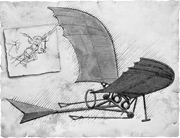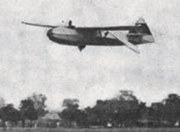E-Archive
Off the Beaten Track
in Vol. 11 - March Issue - Year 2010
Cabbage Leaves

Idea of Leonardo da Vinci for muscle-powered flight

Ornithopter in flight of Schmid
“Melville!” No answer. “You, Melville, where are you?” Still no reply. “Get in here and wash up, right now!” The young boy remained invisible in his hidden corner of the garden, unwilling just yet to join his family at the dinner table. The book which lay before him on the grass was open to an engraving of the ancient Greek legend of Daedalus and Icarus, who flew towards the sun with feathered wings attached to their arms. The boy closed his eyes and tried to imagine the wind rushing through his hair, the dizziness coming from seeing his entire world neatly collected far beneath him. Just think, to fly as free as a bird high up in the clear blue sky…
*****
Since far earlier than human memory, the dream of flying has been with us, not only because of the unimaginable sensation of soaring weightless in the air, but also for the idea of freedom which such a possibility invokes. From legends to actual mechanical contraptions, numerous attempts have been made to imitate the flight of birds, most of them ludicrous, but a few of which actually succeeded.
In about the year 1250 Roger Bacon was among the first scholars to offer the concept of an ornithopter (from the Greek words ornithos “bird” and pteron “wing”), an aircraft that flies by flapping its wings. These first ideas, however, were doomed to remain theoretical, as it was realized that human power was insufficient to lift and sustain a similar vehicle in the air. A couple of centuries later, Leonardo da Vinci came up with mechanical drawings to solve this problem. He proposed to have the aviator lie on a plank and work two wings through a system of levers, pedals and pulleys.
It was not until the late 1800’s that the first unmanned ornithopters capable of flight were built in France by several researchers, each of whom developed his own design and theories. These first constructions, usually reduced scale models, were powered by gunpowder charges activating rudimentary pistons or by rubber bands. Towards the end of the century, an Australian by the name of Lawrence Hargrave built several models powered by steam or compressed air. He also introduced the use of small flapping wings to provide the thrust for larger fixed wings.
The first manned and muscle-powered ornithopter flight took place in 1929, when a German scientist named Alexander Lippisch flew about 300 meters, while in 1942 another German named Adalbert Schmid flew about 900 meters. The significance of both flights, however, has been questioned because of the fact that they were tow-launched, due to the limitations of human muscle power.
Schmid’s ornithopter was especially interesting, as it picked up and developed the design by Lawrence Hargrave. The aircraft weighed a mere 60 kilograms, with a wingspan of about 13 meters. It had a large fixed wing and two smaller flapping wings, each 3.20 meters long, emerging from the side of the fuselage. After being towed aloft, it maintained its initial 20 meter altitude for the entire duration of the flight.
But were these really the first muscle-powered flights? In 1877 an American by the name of Melville Murrell patented something called an “aerial navigator”, which, in a letter dated a year earlier, he describes as working “like a charm”. Family records, preserved by his descendants, tell of how, as a small boy, Melville would attempt to fly by flapping cabbage leaves while jumping from a stone wall on his family farm in Panther Springs, Tennessee. As an adolescent, Melville carved models of flying machines and, inspired by nature, he designed and built his own ornithopter at the age of twenty-one. This machine was further developed over the years and several people witnessed the test flights.
Letters, documents and pieces of Murrell’s machine were donated by his family to the Air Force in 1964 and were subsequently sent to the Smithsonian Institution in Washington, D.C., where they were packed in storage while awaiting suitable arrangement in a new museum of aviation history.
Somewhere in a dark corner of a warehouse, the pieces of Murrell’s machine are waiting to reveal whether his idea actually worked, or if instead the young man was simply living out his childhood fantasies. Perhaps one day we will find out.
By Giovanni Gregorat, Contributing Editor MFN & Sales Manager, Pometon Abrasives
Author: Giovanni Gregorat



























